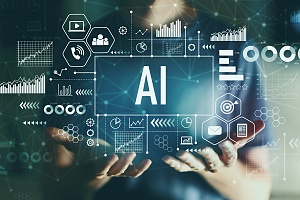 As your organization heads into a new year with optimism and the determination to overcome any challenges, it is an excellent time to look at the most important technology trends for the near future. By gaining a better understanding of these trends, your company will be better positioned to succeed in 2024.
As your organization heads into a new year with optimism and the determination to overcome any challenges, it is an excellent time to look at the most important technology trends for the near future. By gaining a better understanding of these trends, your company will be better positioned to succeed in 2024.
Generative AI and AI maturity
After the end of an initial period of experimentation with AI, 2024 will see companies of all sizes becoming more comfortable with AI and applying it to their processes. The major change that will occur is that companies will use AI not only to mimic or pull from existing concepts and information but to also create and improve designs and products.
Companies in all industries will benefit by having employees who work closely with AI models to help them augment human intelligence and create innovative solutions and processes. This shift from AI adoption to AI maturity will be a result of what technology experts describe as “AI Plus.” AI maturity will occur through AI plus cloud, AI plus security, and AI plus data science as workers in different areas gain expertise in applying AI tools to improve their business processes.
Acceptance of remote work will require better digital tools and platforms
Particularly for small businesses and organizations, the acceptance of remote work will be even more firmly established in 2024. Small businesses will continue to embrace the benefits of remote work including reduced infrastructure costs, access to a global talent pool, and the ability to offer 24/7 services to customers around the world.
To best take advantage of these remote work benefits, organizations will need to prioritize the adoption and utilization of advanced digital tools and platforms to optimally manage and perform their diverse business activities.
Cybersecurity Threat Will Continue To Grow With a Focus On AI
 Small businesses will have to maintain their focus on cybersecurity in 2024 in the face of ever more formidable cybersecurity threats.
Small businesses will have to maintain their focus on cybersecurity in 2024 in the face of ever more formidable cybersecurity threats.
Similar to how AI has made regular jobs easier by completing and carrying out mundane tasks more efficiently, it has also done the same for the efforts of cybercriminals. In short, AI is making it easier to pose as trusted sources or overcome current security safeguards.
On the positive side, AI and machine learning enable organizations to recognize data patterns more easily, which helps security systems learn from past experiences by integrating behavioral analysis. This technology also enables companies to analyze baseline behavior of user accounts, servers, and endpoints more efficiently as well as identify anomalous behavior that could signal an upcoming cyberattack.
Security experts note that 2024 will be a head-to-head competition between cybercriminals using AI to plan and implement more effective attacks versus cybersecurity experts who are using the power of AI to improve cyber defenses.
Cloud Computing Will Shift To Hybrid and Multicloud Environments
Cloud computing will continue its dominance in 2024, but there will be a growing evolution away from one-size-fits-all cloud solutions toward customized hybrid and multicloud environments. Known as “n + 1”, this new cloud approach will allow businesses to have ultimate flexibility with their on-premises infrastructure and cloud tools, which will ensure data redundancy and enable vendor-agnostic solutions.
AI and ML-driven cloud management will become the norm to reduce costs and enhance the performance of cloud operations. Developers will also increasingly engineer cloud tools to better integrate with edge computing tools as described below.
Edge Computing Will Become More Widespread
Small businesses will increasingly explore the benefits of edge computing as a complement to cloud computing. Edge computing processes, analyzes, and stores data at the source where the data is generated near the edge of the network, instead of at a centralized data-processing warehouse. Companies using edge computing run fewer processes in the cloud and move time-sensitive processes to local places, such as on a user’s computer, on an Internet of Things (IoT) device, or on an edge server.
Edge computing provides substantial benefits such as real-time analysis of useful data, reduced latency, improved data security, as well as enhanced mobile computing and IoT technologies.
Customer Experiences Will Improve Through More Advanced AR/VR
 The powerful tools of Augmented Reality/Virtual Reality (AR/VR) will continue to improve and will enable customers to immerse themselves in a potential purchase without being at the vendor location. Some notable examples include retail stores giving customers the ability to virtually try out their clothes before purchasing and real estate companies providing potential buyers and tenants with 360-degree tours of properties online.
The powerful tools of Augmented Reality/Virtual Reality (AR/VR) will continue to improve and will enable customers to immerse themselves in a potential purchase without being at the vendor location. Some notable examples include retail stores giving customers the ability to virtually try out their clothes before purchasing and real estate companies providing potential buyers and tenants with 360-degree tours of properties online.
Businesses that offer these interactive tools to their customers will benefit from increased engagement and higher customer satisfaction.
Neuromorphic Computing Will Become More Popular
Neuromorphic computing is a powerful innovative technology that mimics the way the human brain works, which is being increasingly used by businesses of all types and sizes. It does not work on the traditional computing model, which uses transistors that are either on or off. This architecture also separates out computing and memory with the necessity of shuttling information back and forth via chips. To expand the computing power in traditional computing, more data must be squeezed onto chips.
In contrast, neuromorphic computing does not need the energy and time expended in the traditional computing model nor is it limited by chip size. Its design is modeled on the brain’s ability to do parallel computing and be more fault tolerant, which allows the transfer of information quickly and efficiently.
Technology experts note that this type of computing will enable AI and other powerful technologies to expand and improve rapidly. While it presents great promise for science, business, and medicine, this technology combined with AI is also causing ethical issues and concerns about its rapid advance and similarity to human thinking and behavior.
Expanding 5G Use Will Improve Connectivity and Interoperability
 IT experts predict that subscribers to the 5G mobile network will increase to three billion by 2025 and to nearly five billion by 2028. The powerful 5G mobile network enables businesses to have faster access to applications and greater processing speed on a larger number of connected smart devices and IoT equipment. With the speed and bandwidth provided by 5G, more complex machine learning applications and other advanced tools will be possible on smart phones and tablets. It will also increase automation in diverse industries.
IT experts predict that subscribers to the 5G mobile network will increase to three billion by 2025 and to nearly five billion by 2028. The powerful 5G mobile network enables businesses to have faster access to applications and greater processing speed on a larger number of connected smart devices and IoT equipment. With the speed and bandwidth provided by 5G, more complex machine learning applications and other advanced tools will be possible on smart phones and tablets. It will also increase automation in diverse industries.
5G technology will increase connectivity and will also improve interoperability for a wide variety of devices and platforms. This mobile network will be crucial for supporting the growing use of cloud-based tools, IoT, AI & ML, and AR/VR, as well as edge and neuromorphic computing by small businesses.
Consult With a Trusted IT Support Partner
To better understand and take advantage of these eight important IT trends, we highly recommend you consult and work with a trusted IT Support partner like Network Depot. A dependable IT partner will have the experience and insight into your organization’s unique needs to help you most effectively understand the challenges you will face this year and beyond.
Your IT partner will offer recommendations on the latest and most effective hardware and software tools, IT security applications, and other materials, methods, and equipment, which will assist your small business in overcoming its challenges. By understanding and responding to the trends described in this article and with the valuable assistance of a trusted IT Support partner, your organization will be able to achieve its unique mission more effectively in 2024.